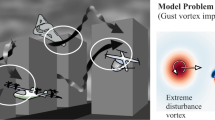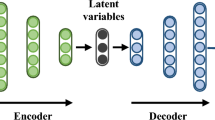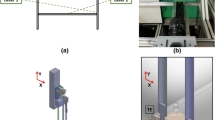Abstract
Effective access to obtain the drag divergence characteristic of an airfoil is crucial for improving the economy, safety, and comfort of the aircraft. Current methods face challenges in providing satisfactory performance concerning efficiency, reliability and generalizability. In this study, an uncertainty-based network is developed, aiming to realize the prediction of the drag characteristic curves and drag divergence characteristics for different supercritical airfoil. To be more specific, a VAE-based network is established, with an encoder to convert the airfoil geometry into low-dimensional latent variables. These latent variables are then simultaneously fed into both the decoder and the drag characteristic prediction network. The decoder is responsible for geometric reconstruction, ensuring that the latent variables maintain a correlation with the geometric features of the airfoil. The prediction network maps the latent variables to the drag characteristic curve. Once trained, the uncertainty distribution of the drag can be realized through sampling from the distribution of latent variables. The analysis of results indicates the model’s outstanding performance, with a mean absolute error of \(7.407\times 10^{-5}\) for the airfoil geometric reconstruction and a mean absolute error of 0.455 count for the drag coefficient prediction. The mean error of the drag divergence Mach number prediction reaches \(2.805\times 10^{-4}\). The results show that the model has considerable potential for engineering applications.



















Similar content being viewed by others
Data availability
The datasets generated during the current study are available from the corresponding author upon reasonable request, subject to further review to ensure compliance with company policies.
References
Vassberg, J., Dehaan, M., Rivers, M., & Wahls, R. (2008). Development of a common research model for applied CFD validation studies. In: 26th AIAA applied aerodynamics conference, p. 6919. https://doi.org/10.2514/6.2008-6919
Zhang, Y., Bai, J., & Qu, F. (2023). Multi-point aero-structural design optimization of wings considering drag-divergence constraints. Journal of Northwestern Polytechnical University (Chinese), 41(2), 241–252.
Hurley, F. X., Spaid, F., Roos, F., Stivers, Jr. L., & Bandettini, A. (1975). Detailed transonic flow field measurements about a supercritical airfoil section. NASA.
Boppe, C. W. (1989). CFD drag prediction for aerodynamic design. In: Technical Status Review on Drag Prediction and Analysis from Computational Fluid Dynamics: State of the Art. AR 256. AGARD, pp. 8-1–8-27
Li, R., Zhang, Y., & Chen, H. (2023). Knowledge discovery with computational fluid dynamics: Supercritical airfoil database and drag divergence prediction. Physics of Fluids, 35(1). https://doi.org/10.1063/5.0130176
Sun, H. (2011). Wind turbine airfoil design using response surface method. Journal of Mechanical Science and Technology, 25, 1335–1340. https://doi.org/10.1007/s12206-011-0310-6
Xia, C., Jiang, T., & Chen, W. (2017). Particle swarm optimization of aerodynamic shapes with nonuniform shape parameter-based radial basis function. Journal of Aerospace Engineering, 30(3), 04016089. https://doi.org/10.1061/(ASCE)AS.1943-5525.00006
Senlin, C., Zhenghong, G., Xinqi, Z., Yiming, D., & Chao, P. (2020). Unstable unsteady aerodynamic modeling based on least squares support vector machines with general excitation. Chinese Journal of Aeronautics, 33(10), 2499–2509. https://doi.org/10.1016/j.cja.2020.03.009
Zhao, X., Wu, W., Chen, W., Lin, Y., & Ke, J. (2022). Multi-network collaborative lift-drag ratio prediction and airfoil optimization based on residual network and generative adversarial network. Frontiers in Bioengineering and Biotechnology, 10, 927064.
Liu, R., Hua, Y., Zhou, Z., Li, Y., Wu, W., & Aubry, N. (2022). Prediction and optimization of airfoil aerodynamic performance using deep neural network coupled Bayesian method. Physics of Fluids, 34(11). https://doi.org/10.1063/5.0122595
Sun, D., Wang, Z., Qu, F., & Bai, J. (2021). A deep learning based prediction approach for the supercritical airfoil at transonic speeds. Physics of Fluids, 33(8), 086109. https://doi.org/10.1063/5.0060604
Zhang, Y., Sung, W. J., & Mavris, D. N. (2018). Application of convolutional neural network to predict airfoil lift coefficient. In: 2018 AIAA/ASCE/AHS/ASC structures, structural dynamics, and materials conference, pp. 1903
Sekar, V., Jiang, Q., Shu, C., & Khoo, B. C. (2019). Fast flow field prediction over airfoils using deep learning approach [Journal Article]. Physics of Fluids, 31(5). https://doi.org/10.1063/1.5094943
Wang, J., He, C., Li, R., Chen, H., Zhai, C., & Zhang, M. (2021). Flow field prediction of supercritical airfoils via variational autoencoder based deep learning framework. Physics of Fluids, 33(8). https://doi.org/10.1063/5.0053979
Yang, Y., Li, R., Zhang, Y., & Chen, H. (2022). Flowfield prediction of airfoil off-design conditions based on a modified variational autoencoder. AIAA Journal, 60(10), 5805–5820. https://doi.org/10.2514/1.J061972
Deng, Z., Wang, J., Liu, H., Xie, H., Li, B., Zhang, M., et al. (2023). Prediction of transonic flow over supercritical airfoils using geometric-encoding and deep-learning strategies. Physics of Fluids, 35(7), 075146. https://doi.org/10.1063/5.0155383
Wang, J., Xie, H., Zhang, M., & Xu, H. (2023). Physics-assisted reduced-order modeling for identifying dominant features of transonic buffet. Physics of Fluids, 35(6). https://doi.org/10.1063/5.0152127
Roskam, J. (1999). Airplane design part VI: Preliminary calculation of aerodynamic, thrust and power characteristics. Design, Analysis and Research Corporation (DARcorporation)
Gudmundsson, S. (2022). Chapter 16—Aircraft drag analysis. In: Gudmundsson, S. (ed). General Aviation Aircraft Design. second edition ed. Butterworth-Heinemann, pp. 657–752
Xie, H., Wang, J., & Zhang, M. (2024). Parametric generative schemes with geometric constraints for encoding and synthesizing airfoils. Engineering Applications of Artificial Intelligence, 128, 107505. https://doi.org/10.1016/j.engappai.2023.107505
Tschannen, M., Bachem, O., & Lucic, M. Recent advances in autoencoder-based representation learning. Preprint at https://arxiv.org/abs/1812.05069
Kingma, D. P., & Welling, M. (2014). Auto-Encoding variational bayes. In: Yoshua, B., Yann, L., (eds). 2nd International Conference on Learning Representations, ICLR 2014, Banff, AB, Canada, April 14-16, 2014, Conference Track Proceedings. Available at https://arxiv.org/abs/1312.6114v10
Rezende, D. J., Mohamed, S., & Wierstra, D. (2014). Stochastic backpropagation and approximate inference in deep generative models. In: International conference on machine learning. PMLR, (pp. 1278–1286)
Kingma, D. P., & Ba, J. (2015). Adam: A method for stochastic optimization. In: Yoshua, B., Yann, L., (eds). 3rd International Conference on Learning Representations, ICLR 2015, San Diego, CA, USA, May 7-9, 2015, Conference Track Proceedings. Available at http://arxiv.org/abs/1412.6980
Hendrycks, D., & Gimpel, K. Gaussian Error Linear Units (GELUs). Preprint at https://arxiv.org/abs/1606.08415
Acknowledgements
This work is supported by the National Natural Science Foundation of China (Grant No.U23A2069).
Author information
Authors and Affiliations
Corresponding author
Additional information
Publisher's Note
Springer Nature remains neutral with regard to jurisdictional claims in published maps and institutional affiliations.
Rights and permissions
Springer Nature or its licensor (e.g. a society or other partner) holds exclusive rights to this article under a publishing agreement with the author(s) or other rightsholder(s); author self-archiving of the accepted manuscript version of this article is solely governed by the terms of such publishing agreement and applicable law.
About this article
Cite this article
Liu, W., Xie, H., Wang, J. et al. Uncertainty involved drag divergence characteristic predicting method based on VAE. J Membr Comput (2024). https://doi.org/10.1007/s41965-024-00139-y
Received:
Accepted:
Published:
DOI: https://doi.org/10.1007/s41965-024-00139-y




